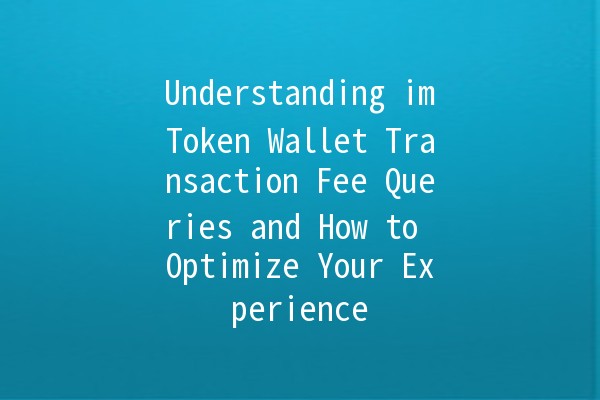In the everevolving landscape of cryptocurrency, the imToken wallet has emerged as a favored choice for many users. As digital asset management becomes more prevalent, understanding transaction fees associated with your activities in the imToken wallet is crucial. This article will delve deep into how to query transaction fees, optimize your experience, and provide practical tips to manage these costs efficiently.
Transaction fees are charges incurred when you conduct cryptocurrency transactions. In the case of the imToken wallet, these fees are determined by multiple factors including network demand and transaction type. It's essential to grasp that these fees are not purely designated by the imToken platform but are influenced by the underlying blockchain network (like Ethereum, Bitcoin, etc.) you are using.

Understanding transaction fees is fundamental to effective cryptocurrency management. High fees can diminish your earnings, especially if you're frequently making small transactions. Conversely, low fees can enhance profitability. This knowledge allows you to time your transactions better, choose the optimal transaction settings, and fundamentally improve your overall strategy in using the imToken wallet.
To check transaction fees, first, open your imToken wallet. When you initiate a transaction, the interface will present an estimate of the fee. This is dynamically calculated based on the current network status and transaction speed preferences you've set.
ImToken provides several transaction speed options: Slow, Average, and Fast. Each comes with its fee estimate. If you don’t urgently need to send your assets, selecting a slower transaction can save you money. Utilizing this feature smartly can significantly mitigate costs.
Several reputable websites and tools track and estimate transaction fees on various blockchain networks. Tools like EthGasStation for Ethereum can provide insights into current network conditions and help you decide the best time to send transactions.
Explanation: Network traffic impacts transaction fees. Transactions made during peak times can incur significantly higher fees.
Example: If you plan to send funds, consider doing it during nonpeak hours or weekends when network activities are generally lower. This could mean reduced fees.
Explanation: The gas price is directly related to the transaction fee. Higher gas prices generally lead to faster transaction confirmations.
Example: If you're using Ethereum, you can manually set the gas price lower if you're not in a rush or the network isn’t congested. Use tools to check current prices to decide wisely.
Explanation: If you're looking to swap tokens, some individuals may not be aware of the fees associated with exchanges within wallets, including the imToken wallet.
Example: To reduce costs, be mindful of transaction fees on both sides of the swap. Compare fees using different platforms or methods before swapping tokens.
Explanation: If you have multiple transactions to send in a short amount of time, consider batching them to avoid paying multiple fees.
Example: Instead of sending ten individual transactions, aggregate them into one where possible to save on fees. Some wallets and services allow this functionality.
Explanation: Layer 2 solutions often provide cheaper and faster transactions compared to the mainnet transactions.
Example: If you’re transacting on Ethereum, consider Layer 2 networks like Polygon or Optimistic Rollups to save substantially on fees while still enjoying the benefits of the Ethereum ecosystem.
Transaction fees are dictated by the underlying blockchain network. Each network has its methods for calculating fees, primarily based on demand (how many transactions are being processed) and the complexity of the transaction. For example, Ethereum's fees can fluctuate widely based on network congestion.
Unfortunately, avoiding transaction fees entirely is not feasible when using blockchains. Every transaction recorded on the blockchain requires miners' work, who are compensated via these fees. However, you can minimize them through optimal timing and choosing the right transaction speed.
Fees change due to supply and demand dynamics on the blockchain. When many people try to make transactions at the same time, the fees can spike. Conversely, during offpeak hours, you may find lower fees. Monitoring these fluctuations can help you time your transactions better.
The imToken wallet does not charge fixed fees for transactions. The fees incurred are primarily based on the blockchain's structure you are utilizing (like Ethereum). However, imToken may impose small fees for specific operations conducted within their service.
You can gauge future transaction fees using thirdparty tools that analyze historical fee data and current network utilization. Many feature trend analysis that enables users to make educated predictions regarding when to conduct transactions.
If you set the gas price too low, your transaction may remain unconfirmed for an extended period or might not be processed at all. The network picks transactions based on the gas price offered, so lower offers may be deprioritized.
Navigating the intricacies of transaction fees when utilizing the imToken wallet is paramount for anyone looking to engage with cryptocurrencies effectively. By understanding how fees work, sourcing accurate information regarding estimations, and leveraging the tips provided, users can manage their transaction costs more efficiently. Always stay informed, plan accordingly, and remain proactive in your digital asset management to make the most out of your imToken wallet experience. Happy transacting!